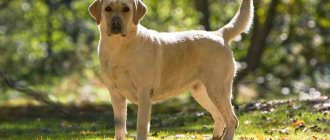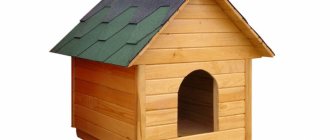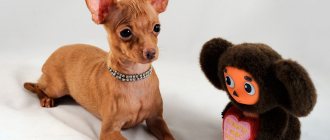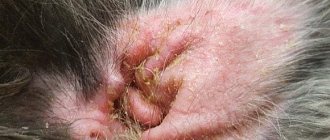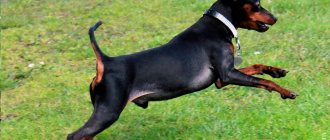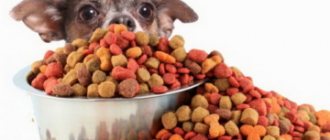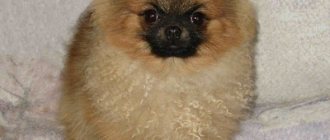From their distant ancestors - Canadian small Newfoundlands and English retrievers, Labradors inherited boundless devotion to their owner and excellent working qualities.
Originally bred for gun hunting, Labradors are now more often used as companion dogs, guide dogs, and rescue dogs.
The first Labradors were brought to the USSR in the 60-70s of the last century, but they were not particularly popular and did not enjoy universal love.
Everything changed in 2000, when Sergei Shoigu, who was then head of the Ministry of Emergency Situations, gave a Labrador puppy named Connie Polgrave to Russian President Vladimir Putin.
After widespread press coverage of this event and subsequent frequent reports about the life of Putin's dog, Labradors became one of the most popular breeds in our country.
Do mini Labradors exist and what do they look like in the photo?
Many people dream of owning a Labrador.
But Connie’s relatives are large , energetic animals, which are quite difficult in a city apartment .
Therefore, the appearance of information about the sale of dwarf or mini Labrador puppies aroused genuine interest among dog lovers.
However, such a breed does not officially exist . The mini Labrador, small or dwarf breed is not registered with any international or national canine organization in the world.
Labradors whose weight and height are less than those specified in the breed standard are considered defective . Such dogs are prohibited from breeding and are not allowed to participate in exhibitions.
Are Labrador and Retriever the same thing?
The Golden Labrador Retriever and the Golden Retriever (or Golden Retriever) are two different breeds.
The fact is that a retriever (from the English “retrieve”) is a type of dog that is designed to bring prey that has fallen to the ground or into the water to its owner during a hunt.
The Labrador Retriever is a subspecies of retrievers. For the first time, the Labrador breed was named the St. John's Water Dog, in honor of the capital of the island of Newfoundland and Labrador. This breed was used as fishermen's helpers.
Golden Fawn Labrador Retriever:
Golden retriever:
How did you appear?
There is no clarity about the origin of the mini Labrador.
There are several options for the appearance of a reduced dog:
- The result of a genetic mutation when producing offspring from a dwarf father and a standard mother. Conscientious breeders discard such puppies.
- Obtaining offspring from relative dogs is interbreeding (inbreeding). In this case, the puppies receive two identical “wrong” genes, their growth slows down and stops before reaching the breed standards.
- Crossing dogs of different breeds. There are many known Labrador mixes. Mixing with a German Shepherd produces a Labron German, and mixing with a Poodle produces a Labropoodle. However, these are quite large breeds. A mini Labrador puppy will most likely be born thanks to a small mongrel.
- The cause of dwarfism may be diabetes mellitus, disorders of the cardiovascular system and thyroid gland, hydrocephalus, growth hormone deficiency, kidney dysfunction, skeletal dysplasia, hormonal imbalance in parents.
Stories that mini labs are very popular outside of Russia are lies.
Pedigrees with seals of foreign cynological organizations and communities are a deliberate lie. The version that unique dogs were bred for burrow hunting and detaining criminals also does not stand up to criticism.
History origin
The Labrador is a large enough dog to live carefree in an apartment. There will always not be enough space for either her or you. But at the same time, this dog has plenty of advantages. That's why many people dream of having a pet Labrador.
Dreams simply must become reality, even if it is difficult to believe that what is happening is not a fantasy. Yes, indeed, today everything is possible and a new species that exactly replicates a copy of a popular large animal, only smaller in size, also actually exists.
How could this happen? As with other difficult questions, there will be several answers:
- a man intervened. Dog handlers were interested in developing a new breed that would be more satisfying in size than the original. Labrador is one of the most popular breeds and the demand for it would be even greater. How many apartment dwellers dream of this four-legged friend, but are afraid of the large size of the animal and the small square footage of their own home. The parents of the mini Labrador were a female of the usual standard and a male dwarf Labrador. As a result, the father's genetics turned out to be stronger, and humanity received something average in size and identical in all other respects to a domestic animal,
- inbreeding. If you cross two close relatives, the genetics may fail. This is what happened with puppies that received two completely identical defective genes. As a result, growth slowed down and stopped at a level below fifteen centimeters of the height of a standard adult individual. In addition to short stature, the animal may suffer from other genetic diseases.
Despite such questionable origins, the new variety of mini-Labradors immediately fell in love with many . Contrary to fears of genetic diseases, mini Labradors look quite healthy and happy with life. They have the same energy and need for active games as the standard representatives.
Description of the breed and character of the pets
Based on the fact that the origin of mini Labradors is vague, it is very difficult to make assumptions about the nature of these animals.
Theoretically, the puppy should inherit the characteristic features of Labradors:
- friendliness;
- lack of aggressiveness towards other animals (excluding birds) and strangers;
- devotion to the owner;
- cheerfulness, energy;
- efficiency at work;
- high learning ability;
- agreeableness.
However, it should be borne in mind that mestizos may exhibit traits of a parent of a different breed that are completely uncharacteristic of Labradors. Not all of them appear in childhood.
It happened that an obedient and kind dog turned into an uncontrollable evil monster after a couple of years..
Small dogs are overly aggressive, fussy, intrusive, prone to hysterics, and often bark for no reason.
Expert opinion
Kozhevin Semyon Kirillovich
Expert dog handler.
This breed is unknown to me. Most likely, this is another fake from unscrupulous sellers. I can assume that the dog will have problems related to genetics. Inbreeding or the presence of the dwarfism gene leads to the accumulation of diseases characteristic of the breed; moreover, the offspring retain a recessive gene responsible for growth, and it is impossible to accurately predict the size of the dog. In the case of mestizos, there is no need to talk about the purebred puppy at all.
Advantages and disadvantages
Assuming that the mini version has retained the basic qualities of large Labradors and acquired new ones, the advantages of the breed include:
- compactness, ease of maintenance in urban environments;
- excellent service qualities;
- possibility of use as a “nanny” for children, a guide, a companion;
- good nature, playfulness, sociability.
Cons of the breed:
- poor tolerance of loneliness;
- excessive hyperactivity due to improper upbringing;
- year-round molting;
- need for long walks;
- cannot be used as a guard dog.
Girl or boy
Who to choose - a boy or a girl? This question is often asked by people who want to buy a dog. The difference is insignificant, but there are some nuances that require description.
The main problem that the owner of a girl may face is estrus. Its consequences can be both damaged furniture and unwanted pregnancy. But Labradors are fairly clean dogs, so there shouldn’t be any problems with dirty furniture. To avoid unwanted pregnancy, it is necessary to closely monitor the dog during heat and drive away the yard "gentlemen". In general, girls are considered easier to train and have a gentler disposition than boys.
Similar article: What is remarkable about the chocolate-colored Labrador?
The boy is slightly larger than the girl and is more difficult to train. In addition, when meeting a female dog who is currently in heat, it can be very difficult to control. However, when choosing a male, you can rest assured: no one will bring you puppies in the lap.
We recommend this article:
What is the difference between a Golden Retriever and a Labrador and which is better?
Dimensions, weight and other distinctive features
There is no standard for the Mini Labrador breed.
The main distinguishing feature of mini Labradors is their height.:
| Breed and gender | Height at withers | Weight |
| bitches | 54-56 cm | 24-32 kg |
| males | 56-57 cm | 28-36 kg |
| Puppy aged 1 month | 23-23.5 cm | 3.4-3.5 kg |
| Puppy aged 3 months | 50-55 cm | 12-14 kg |
| MINI LABRADOR | ||
| bitches | 38-46 cm | No data |
| males | 40-48 cm | No data |
True "full-size" Labradors have a dense, short, straight (no wavy) coat, thick, coarse with a waterproof undercoat.
Colors: solid black , liver, chocolate , fawn (from light cream and golden to rich red ) . A light spot on the chest is acceptable, but not desirable.
Soft, wavy, curly fur indicates the presence of blood from dogs of other breeds.
From 3 to 4 weeks - development of feelings
At this time, the puppy will quickly develop all its senses. He will begin to recognize his environment, as well as people and all objects around him. At this stage, you must especially carefully protect the puppy's safety: from loud noises and other sudden situations that can greatly affect the development and character of the future dog.
It is extremely important that the puppy stays with its mother at this time and learns “how to be a dog” and how to interact with its own kind. Starting at 3 weeks of age, puppies learn:
- Basic behavioral patterns of dogs;
- The meaning of bites, and what it's like to be bitten;
- The meaning of various postures and their effect on other animals;
- The meaning of barking and other sounds;
- How to establish and develop relationships with other dogs.
Photos of Labrador puppies 4 weeks (1 month):
Lifespan
The average life expectancy of Labradors is 10-14 years . Mini Labradors from 8 to 12.
Such a significant difference is explained by the accumulation of genetic abnormalities.
Inbreeding or the presence of the dwarfism gene leads to a decrease in the dog’s body’s resistance to various diseases and rapid aging.
Dog diseases
Mini Labradors are not known for their good health.
A partial list of diseases includes :
- dysplasia of the elbow and hip joints;
- lipoma;
- retinal atrophy, cataracts, conjunctivitis;
- periodontal disease, tartar;
- angio- and lymphosarcoma;
- food allergies;
- bloating;
- epilepsy;
- atopy;
- mast cell tumor (mastocytoma);
- stroke;
- unilateral and bilateral cryptorchidism (absence of one or two testicles);
- hydrocephalus;
- gastrointestinal dysfunction.
IMPORTANT!
Castration is a good prevention against many diseases.
The operation has a positive effect on brain function, stabilizes the release of hormones, and has a beneficial effect on the dog’s behavior.
Care and maintenance
Caring for mini Labradors is no different from caring for their larger counterparts and consists of::
- regular (at least once a week) combing and cleaning the fur from dirt with a soft brush;
- cleansing the ears;
- daily eye rinsing;
- trimming claws as they grow;
- not frequent bathing with a small amount of zoo shampoo (only for severe contamination);
- checking after every walk for ticks;
- seasonal treatment with special preparations against parasites;
- daily long walks (at least two hours);
- active games, significant physical activity.
Miniature dogs require constant monitoring by a veterinarian, compliance with the schedule of vaccinations and preventive examinations is required..
The baby should have his own place with a comfortable bed, separate dishes for feeding and drinking, a harness, and a leash. You can't do it without training.
Considering the unpredictability of the dog’s temperament, as it grows, it is advisable to ensure that the initial course and subsequent behavioral adjustments take place with the participation of a professional trainer.
Basic rules of care
Every dog breeder should know that proper care for a pet involves carrying out the correct preventive and hygienic procedures. It is necessary to accustom your pet to these procedures from an early age so that he gets used to them and reacts to them adequately.
Since another family member has appeared in your family, you will have to stock up on a certain kit for caring for the appearance of your pet:
- cotton swabs (for cleaning ears);
- toothbrush; wire bristle brush;
- massage brush-mitten;
- slicker brush;
- nail clippers;
- a basin with a rubberized bottom (for bathing);
- shampoo;
- separate towel
Dog owners are always interested in the question of bathing frequency. A Labrador does not need to be bathed very often, since the dog’s skin has protective coverings that are washed off with frequent bathing.
Labradors love water, so they usually don't cause problems when bathing. It is necessary to remember the temperature of the water (no more than 40 degrees), as well as washing your hair carefully to avoid water getting into your ears.
There is no need for daily brushing of a Labrador. During the shedding period, which happens 1-2 times a year, the dog needs to be brushed regularly to remove dead undercoat and keep the house clean.
IMPORTANT!
After walks in the forest or near bodies of water in the warm season, you should comb your dog with a special comb with metal teeth, which removes thorns and ticks.
Labradors have fairly long nails that need to be trimmed carefully to avoid damaging the pink “flesh.” The procedure is performed with special tweezers, and not with office scissors, which will crumble the claw. If your pet often walks on asphalt, then its claws are ground down to the required level and do not need regular trimming.
You can clean your dog's teeth with a toothbrush or special teeth cleaning products, which can be purchased in specialized stores. A healthy Labrador's ears contain a small amount of wax, which should be cleaned out once a week with a dry cotton swab. If the ear is very dirty, you can moisten a swab with vegetable oil and gently clean the dog’s ear.
Proper feeding
Both large and small Labradors are very voracious.
It doesn’t matter are fed industrial feed or natural products, the main thing is to avoid overeating and follow a few simple rules :
- Do not mix dry food and natural products. This can lead to indigestion and the occurrence of gastritis, ulcers, and cancer.
- Portions should be appropriate for age, weight and level of physical activity. Normally, a dog with optimal weight should have easily palpable ribs.
- When feeding industrial feeds, preference should be given to brands with a protein content of at least 60%. This is especially true for puppies during the period of active growth.
- The menu should not include pork, raw river fish, milk, legumes, baked goods, fresh bread, smoked meats, pickles, products containing spices, seasonings, flavorings, legumes, potatoes.
- A menu consisting of natural food should be enriched with a vitamin complex, a recipe for which can be prepared after consulting with a veterinarian.
NOTE!
The share of meat or offal in a properly formulated diet should be at least 50%, and vegetables, herbs, and seasonal fruits - 25%. The remaining 25% of the portion includes cereals, low-fat fermented milk products, boiled eggs (no more than two per week).
Diet of a small Labrador
A dog, if it is fed correctly, always has the same weight, looks healthy, its coat is shiny and free of dandruff. A good appetite is an indicator that the dog is being fed properly. At a young age, it is better for the pet to be rather thin in appearance than fat, so as not to interfere with the development of tendons and joints. It is better to stick to the diet that the breeder practiced, and only introduce new products over time.
Approximate daily diet for a small Labrador: meat 15 g per 1 kg of dog weight, carbohydrates - 5 g per 1 kg of weight, fats - 2 g per 2 kg of weight. Don't forget to drink - clean water should always be available. Stick to the formula above and avoid:
- fatty pork;
- sausages;
- peppery and spicy foods;
- bones (can lead to constipation);
- spoiled products;
- any sweets.
How many times should you feed your puppy?
Until two months of age, Labrador puppies eat 6 times a day. Do not feed the puppy at night; distribute these 6 feedings throughout the day approximately every 3.5-4 hours, and then, as the number of feedings decreases, increase the interval between them. From 2 to 4 months the puppy is fed 5 times a day, from 4 to 5 months - 4 times, from 5 to 6 months - 3-4 times. From 6 months, gradually transfer your Labrador puppy to the diet of an adult Labrador. From the age of 6 months, feed your Labrador twice – in the morning and in the evening, at certain hours.
What to feed with a natural diet
If you feed your Labrador with regular food, it is important to properly balance the diet. Remember: Labrador puppies are not gourmets, there is no need to try to diversify their food - it is better for the food to be the same, but always complete. Any flavoring additives (spices, ketchups, mayonnaise, etc.) are harmful and dangerous for a dog. Include in your diet:
- Meat is a large part of natural nutrition. Any part of beef is included in the diet (goulash is suitable, take tendons, veins, trachea, cheeks), lamb is recommended. Give the meat raw, fresh or after freezing. You cannot cook it for a long time if it is intended for a dog.
- Vegetables and fruits, herbs (vegetable components are given lightly stewed in a frying pan, boiled in water).
- Porridge. Keep in mind that many people love buckwheat and are allergic to it.
- Pork stew: recipes with photos
- Treatment of ankle sprains, swelling and bruises with ointments and compresses
- Rice porridge with pumpkin: recipes with photos
Premium ready-made food
When feeding your Labrador with ready-made food, there will be no problems with choosing a diet. The question is one thing - the food needs to be selected successfully. Buying the most expensive one will not guarantee that it will suit your dog. Buy food in small packages at first. Study how your Labrador reacts to it, whether there are any allergic reactions: check for redness in the ears, belly, and interdigital spaces. See if your Labrador eats this food with pleasure. Pay attention to dry food from the Holistic line.
How to choose?
There are no nurseries breeding mini Labradors.
Those who want to get a dog will have to rely on online advertisements from individuals, or buy a puppy second-hand at the market. It is unlikely that the buyer will be able to visit the “kennel” itself, meet the puppy’s parents, and look at the conditions of detention.
Therefore, recommendations when choosing a baby can only be the most basic.:
- The general physical condition and activity of the puppy should be assessed;
- if you touch your tummy, it should not be swollen;
- you need to carefully examine your teeth, eyes, skin, and coat condition;
- check if there is any discharge from the nose, ears, if the fur in the anal area is clean;
- take a closer look at the gait and movements;
- you need to observe behavior, look at relationships with other pets;
- study puppy and veterinary records.
Buying a mini Labrador is similar to playing the lottery. Most likely you will be unlucky, and you will get a ridiculous creature of an unknown breed.
In the best case scenario, the dog will be healthy, easy-going, and will bring joy into your life . At worst, you will have to constantly treat your pet and adapt to its inappropriate behavior.
In any case, it is your choice, the main thing is that it is conscious.
What to look for when purchasing
In order not to make a mistake in your choice, you need to know exactly what a healthy Labrador puppy looks like. Although there is an opinion that when buying a puppy it is impossible to predict how it will grow up, it is worth doing everything to ensure that your choice is successful. Therefore, now we will characterize the puppies that are most likely to grow up to be real handsome dogs.
We recommend this article:
Can a Labrador live in an outdoor enclosure in winter?
External indicators
To identify a healthy puppy with excellent performance, pay attention to the following indicators:
- Hairline. The outer layer of wool, according to the standard, is very coarse and hard, but the undercoat is smooth and silky. In addition, the undercoat should be thick. All other cases (sparse undercoat, too long coat) are not included in the standard and are considered unsuitable for dogs of this breed.
- Dog's tail. It should resemble an otter's tail, which allows the animal to swim well. It should be short and thick at the base (as thick as a human arm), and slightly tapered at the bottom. When moving, it should be lowered, without rising above the level of the back. As a rule, such a tail is formed in individuals with a short back, so pay attention to this. If the tail is too long or too thin, you are unlikely to win a prize at a dog show.
- Muzzle expression. Everything is simple here - the Labrador should look as friendly as possible. No heavy or cloudy look.
- Body structure. The baby should have a deep chest and a fairly long neck, and the head should be quite large.
Similar article: Weight of a puppy and an adult Labrador by month
Labrador behavior
The Labrador's character is very important, since the pet must become a full member of the family. To determine whether a puppy is worth buying, take a closer look at its behavior - it should be active and friendly. If you pick up your baby, he should not be afraid or behave aggressively. As a rule, you should notice that the dog enjoys human contact. You can gently clap your hands above his head and look at the dog’s reaction - if the baby is very scared, you should not take such a puppy.
Other subtleties
When choosing a puppy, make sure that he is absolutely healthy. Carefully examine his paws, make sure that there are no dislocations or improperly fused bones. Also carefully examine the ears and eyes - they should be clean, without any signs of disease. Sour eyes or dirty ears are clear evidence that the baby is being neglected.
It is very important that he is kept clean and fed enough. Look where the puppy is kept - the place should be clean and comfortable. You can also check what kind of food he is given - there should be enough of it, and the quality should be high.



